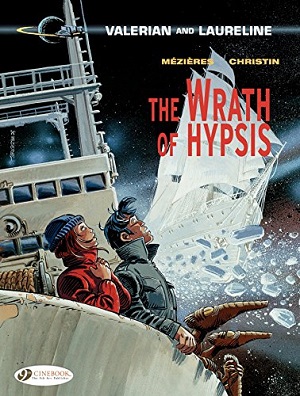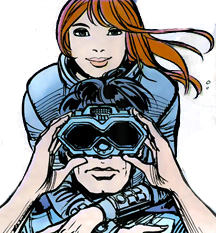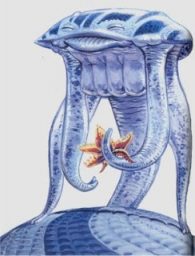Valerian and Laureline: Ghosts and Wrath
Thursday , 20, April 2017 Book Review, Comics, Fiction 5 CommentsLast month’s review of Ambassador of the Shadows introduced the BD comic of Valerian and Laureline, a legendary science fiction adventure with a forty-five year run. Influencing visual science fiction such as Star Wars, The Fifth Element, and various anime, in summer 2017, this classic tale will arrive on the silver screen in Valerian and the City of a Thousand Planets. While Ambassador of the Shadows was a landmark story, featured in Heavy Metal magazine, it focused on Laureline’s search through Point Central in search of a missing ambassador and her Valerian. Save for a sweet kiss when Laureline reunited with Valerian, little of the namesake hero appeared in that book. To fully appreciate the characters, one would have to read additional stories, such as the pivotal two part adventure of Ghosts of Inverloch and Wrath of Hypsis.
In Ghosts of Inverloch, twin catastrophes face the Earth. In the 1980s, the nuclear powers are losing control of their arsenals through a quiet string of accidents. In Valerian’s present, a wave of causality caused by spatio-temporal agents threatens to erase Galaxity and the Earth from space and time. To prevent these cataclysms, assignments are handed out that bring Laureline, Valerian, the trio of alien shingouz, an aged British pilot, the inventor of spatio-temporal technology known as Mister Albert, and Valerian’s boss in the Space-Time Bureau to Inverloch. Together, this assembly must discern the hand of Hypsis, Galaxity’s rival, in these events, and foil it. But before he can arrive at Inverloch, Valerian must kidnap a Glapum’tian, an aquatic genius that looks like a baleen squid ray, from its homeworld. The book ends shortly after all the parties arrive, with a growing sense of dread as Valerian’s boss reveals the cost of failure. There’s not a story self-contained within this volume, just vignettes of what each party was doing prior to arriving at Inverloch.
Ghosts is an important volume in the progression of the Valerian and Laureline series. Not only does it set up the defining moment of the series, the disappearance of Earth and all of humanity besides Valerian and his Laureline, it also rehabilitates Valerian from the three volumes of abuse his character has suffered. Valerian and Laureline is an unashamedly feminist series, wasting no opportunity to show that Laureline’s indirect and social approach to solving problems is better than Valerian’s straight-forward and muscular ways. Since Ambassador of the Shadows, Valerian had been reduced over time to little more than a dumb brute as Laureline’s girl power ruled the day. However, writer Pierre Christin and artist Jean-Claude Mézières realized that Valerian was slipping into parody and reversed course with Ghosts. Here, Valerian must complete his abduction of the Glapum’tian alone. His repeated failures force him to abandon the direct approach of the boy scout hero for a cunning more in line of a pulp hero. This gives depth to Valerian, providing a male lead who can stand next to the strong-willed Laureline, and one she can’t keep her hands off of. It is not the contrast of weak man and strong woman that makes Valerian and Laureline work, but the complimentary nature of a strong man and strong woman together. Laureline still gets to break the ties, though, as Christin and Mézières still espouse the superiority of the feminine in their stories. (Of course, their sense of the masculine is a strawman, but that’s an essay for another time.)
 In Wrath of Hypsis, the assembled team heads out into the Arctic, in pursuit of the ghost ships seen nearby each nuclear accident. Using the Glapum’tian’s ability to talk to orca and other aquatic species, they chase down one such ghost ship. As the vessel rises from the waters, it sinks their ship. When Valerian’s spaceship picks up the shipwrecked crew, each member of the team pitches in to pursue the ghost ship across time and space to the hidden planet of the Hypsis. There, in the presence of three aliens claiming to be the Trinity, Valerian and Laureline must choose which Earth to save. For to save Galaxity, the old Earth must burn.
In Wrath of Hypsis, the assembled team heads out into the Arctic, in pursuit of the ghost ships seen nearby each nuclear accident. Using the Glapum’tian’s ability to talk to orca and other aquatic species, they chase down one such ghost ship. As the vessel rises from the waters, it sinks their ship. When Valerian’s spaceship picks up the shipwrecked crew, each member of the team pitches in to pursue the ghost ship across time and space to the hidden planet of the Hypsis. There, in the presence of three aliens claiming to be the Trinity, Valerian and Laureline must choose which Earth to save. For to save Galaxity, the old Earth must burn.
The idea that the gods (and God) might be alien instead of divine appears with frustrating regularity in science fiction. Typically, the idea is played straight to shock the squares and destroy organized religion in a setting. Here, the revelation that the Hypsis are aliens that think they are the Trinity is still played for shock. However, the Galaxity team is nowhere near as credulous as the protagonists of other stories, maintaining a healthy doubt while humoring the noir flatfoot, hippie, and talking calculator claiming to be Father, Son, and Spirit. This is with good reason, as Hypsis’s attempt to destroy Galaxity, by nuking 1980s Earth, would instead provide the instigating event that leads to Galaxity’s creation. Similar contradictions between claim and deed only reinforce the doubt in the Hypsis aliens’ identity. While the subtle touch is appreciated, the inclusion of this divine masquerade was unnecessary, as any other time-travelling civilization could have been swapped in without affecting the story. The plot and the Chekov’s guns leading to the confrontation demanded that Hypsis exist, not that Hypsis be the Trinity. Without those hints, this was a swerve for a swerve’s sake. Fortunately, the anime adaption of Valerian and Laureline retcons away this version of Hypsis, starting immediately after Earth’s disappearance.

Valerian’s mind wanders while he is on his mission.
It would not be a Valerian and Laureline adventure without at least one page’s panels devoted to Laureline running into Valerian’s arms and greeting him with a kiss. She rarely passes up a chance to wrap an arm around her hero, and Valerian does his best to show off in front of his girl. When separated, their thoughts turn to each other. Their devotion to each other is complete, and those who have come to know the couple recognize it. When the Galaxity agents depart to wherever the future Earth is hidden, Mister Albert and the shingouz pull strings to keep Valerian by Laureline’s side. In a youth culture age concerned more with dating and the bedroom, it is rare to see such a deep and mature bond presented in media.
The developments in printing technology have been kind to Valerian and Laureline. Gone are Laureline’s days as a sun-scorched teenager, but also gone are the watercolor shading and themed palette of Ambassador of the Shadows. Instead, the wider palette available allows a more realistic color scheme from panel to panel, but one that does not attempt to emulate the photo-realistic backgrounds of titles like Yoko Tsuno. These additional tools allow Mézières to create stunning images in his booking, including aquatic scenes with the Glapum’tian swimming with orca as well as the amazing cover to Wrath of Hypsis. And as the printing technology matured, so too did the character designs. Laureline has grown more mature in character and in design since her rowdier teenage days in Ambassador of the Shadows, while Valerian has grown craggier. The lapses into comedic design that occasional punctuated Ambassador are nowhere to be seen, at least until the Son takes the stage. Finally, the fanservice is still a matter of line and pose instead of nudity. The universe loves Laureline, and so does the camera. Fortunately, Mézières does not use outright preening like many current manga and comics artists do.

The Glapum’tian
Despite the deus ex machina muddying the ending, the combined adventure of Ghosts and Wrath provide a passable but clockwork chase story enlivened considerably by the antics of the shifty shingouz and Laureline herself. The world may turn because of Laureline’s interactions with the people and aliens around her, but it turns around Valerian and his guiding light of Galaxity. But now that Galaxity is gone, the real mystery is not what the Hypsis Trinity might do next but how Valerian and Laureline will cope when the only thing they have in the universe is each other. Well, each other, Valerian’s spaceship, and the three shingouz who follow Laureline around like puppies, that is…
Fortunately, Cinebook is committed to publishing the complete adventures of Valerian and Laureline, with nineteen of the 21 volumes to be published by year’s end, so there is no danger of missing out on what happens next.
Great review and fair one. The series is endearing if infuriating at times- at least to me.
I don’t remember Yoko Tsuno’s colour palette being photorealistic. Perhaps I was reading the 80’s version of the BD
Unfortunately, I don’t live in a Francophone region to refresh my memory.
I agree that the latent women are better than men, did grate on me in the Valerin stories. It was one of the reasons that while I enjoyed the reading the series randomly (I read the French editions) I was put off with Valerin coming off as a mix of dolt and doofus sometimes. However, I do like Laureline’s femininity. It strike me as very French (or Latin) and the illustrators do draw her very lovingly. She’s a bit of a headturner
Again, I wish I could review the series to correct any misunderstanding.
All in all I do recommend it despite my subjective ambivalence towards the series
“The idea that the gods (and God) might be alien instead of divine appears with frustrating regularity in science fiction.”
Not to get off the topic of classic French comics, but this angle has really blunted Marvel’s Thor movies for me. Odin literally screaming “We are not gods!” is such a non-Odin thing to say, and it narrows the possibilities for the characters, turning them into knock-offs of Star Trek aliens. None of the grandeur of the best comics is present.
